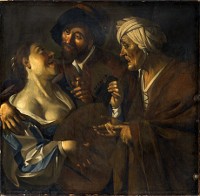 As I mentioned earlier, art theft is relatively rare since it’s extremely difficult to re-sell stolen art. Unfortunately, one type of theft remains prevalent: forgery. The history of art is riddled with stories in which hucksters sold forgeries as original works by master artists. For anyone familiar with this aspect of the art world, the news out of London that a 17th Century painting in the Courtland Institute is actually a 20th Century fake should come as no surprise.
As I mentioned earlier, art theft is relatively rare since it’s extremely difficult to re-sell stolen art. Unfortunately, one type of theft remains prevalent: forgery. The history of art is riddled with stories in which hucksters sold forgeries as original works by master artists. For anyone familiar with this aspect of the art world, the news out of London that a 17th Century painting in the Courtland Institute is actually a 20th Century fake should come as no surprise.
As recently as 2009, it was reported that curators at the Courtland along with ones from the National Gallery thought the painting had “every appearance of being of 17th-century origin.” On one aspect most curators agreed: it was not an original work. The Courtland piece was thought to be a 17th Century anonymous copy of a 1620s brothel scene by Dutch master Dirck van Baburen.
Scientific tests commissioned by the BBC program Fake or Fortune? revealed its actual origins. A detailed examination of the paint determined that it contained a “synthetic resin similar to Bakelite” which is added to mimic age. Consensus now holds that it was the work of the famous 20th Century forger Han van Meegeren.
